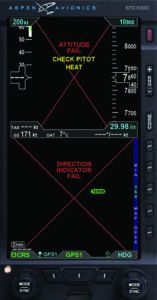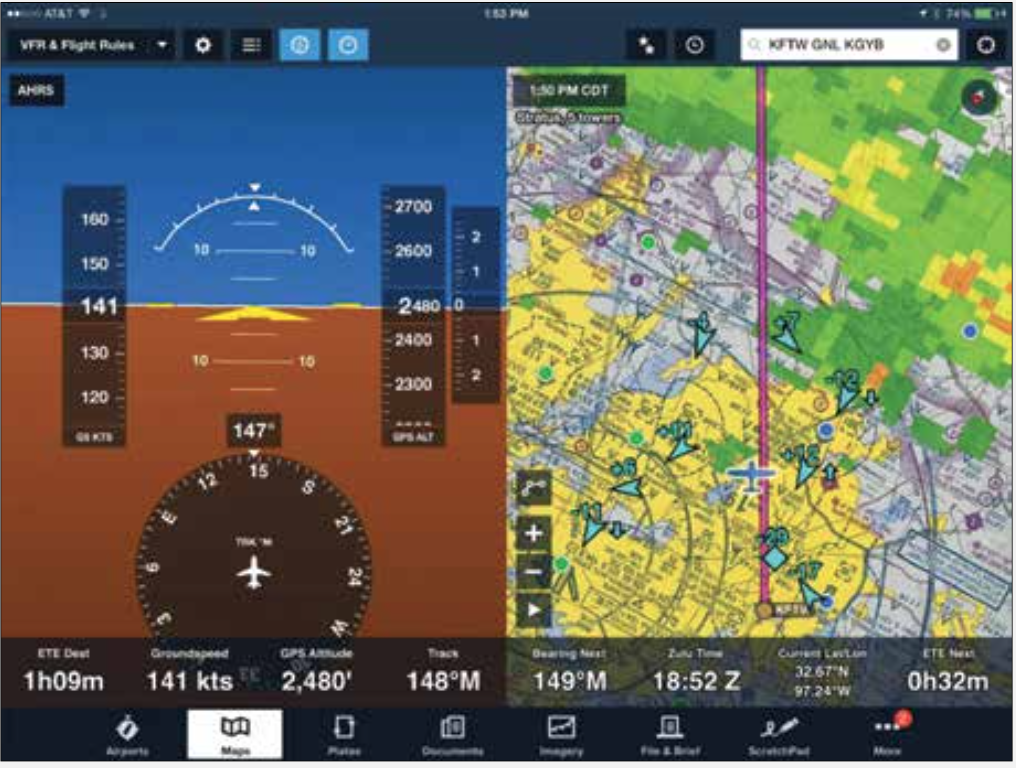There you are, droning along in the clag toward your destination. You still have over an hour before your ETA and the frequency isn’t all that busy, so you’ve eased the seat back a bit to stretch your legs while George flies. In a few minutes, you’ll get the ATIS and load the expected approach, then brief yourself on the letdown and vectors to final. While you’re chatting with the passengers, you hear a faint beep and sense a wing has dropped a bit.
You look back at your instrument panel and the primary flight display panel is showing several red X’s where flight information used to be, including attitude, heading and airspeed. Before you reach for the yoke, a glance at the backup “steam” gauges shows you’ve entered a slight descent and you’re in that slight bank. The moving map still works, and you can navigate and communicate, but you have to start flying partial-panel on the backup instruments. Congratulations; you’re experiencing an IFR emergency.
THE DIFFERENCE FROM VFR
The good news is there’s nothing wrong with the airplane. Except, you know, that the primary flight instruments have failed. The engine is running fine and the weather is relatively benign, although IMC. There’s no fire, smoke or even a hint of unwanted combustion. As you start putting the backup flight instruments in your scan, you add some system checks. The electrical system looks good. So does the engine oil pressure and the various temperatures, fuel and everything else. But you don’t have your primary flight information.
This situation differs in many ways from what we might term a VFR emergency, where an engine, system or component failure means we either will or will need to be on the ground soon. There’s no medical emergency on board, and the weather isn’t closing in or sitting between you and your destination. You’re IFR already and in the system, and ATC is only a button press away. So there’s no urgency, as there certainly would be with other emergencies. So, don’t panic.
Of course, your situation may be a bona fide emergency. You could be on fire, lose your only engine, have a sick passenger or be having your own medical emergency. You already have trained for things like that, but this failure isn’t that dramatic or urgent.

The FAA’s Aeronautical Information Manual (AIM), at paragraph 6-4-1, tells us, “It is virtually impossible to provide regulations and procedures” dealing with all possible communication failures. The AIM details the lost-comms-under-IFR rule, FAR 91.185. The rule and AIM guidance boil down to where, when and how high.
Where
Where you should go when you’ve lost comms depends on what ATC told you. The first choice is, of course, to fly the route in the last ATC clearance you received. If being vectored, go to the position in the vector clearance. If you’ve not been assigned a route, proceed along the route assigned in an “expect to” clearance. If there is no assigned route, no vector and no “expect to” clearance, fly the flight-planned route.
When
When there is an “expect further clearance” (EFC) time, descend or descend and execute the approach at the EFC. If there’s no EFC, use the flight-plan ETA. If the clearance limit is not associated with an approach, leave it at the EFC time if you have one. If none has been received and you’re at the clearance limit, fly to an approach fix and descend/approach at your ETA.
How High
Altitude is the final consideration. You’re supposed to be at the higher of 1) the altitude assigned in the last clearance, the 2) minimum altitude for IFR operations or 3) the altitude in an EFC.
If the pilot received an EFC altitude and the failure occurs after the EFC, the expected altitude is “not applicable,” according to the AIM. The pilot should maintain the higher of 1 or 2 above. If the pilot receives an EFC at a lower altitude, they should maintain the higher of 1 or 2 until the EFC time.
TROUBLESHOOTING
You’re fairly sure the problem is in the hardware driving the primary flight display, probably the AHARS or ADAHRS, if so equipped. It could be a hard, internal failure requiring component exchange, but you’re fresh out of working examples of the proper part right now. It also could be something really simple, like a clogged or broken static line. Selecting the alternate static system is the way to test for that failure. Switch to the alternate system and leave it there, to see if anything changes.
Cycling the PFD’s circuit breakers might be an appropriate next step, but only if you’re sure you know which ones do what, and attack them one at a time. After resetting a breaker, wait at least a couple of minutes to see if the system clears its fault and reboots itself. Stranger things have happened. Then pull and reset the next one, if any, associated with that system. Repeat as necessary, except don’t reset a popped breaker more than once. There’s a reason it broke the circuit, and resetting it multiple times only gives what should be a small problem more opportunities to become a larger one.
The equipment itself may tell you what’s wrong. Presuming at least some of the glass panel is still working, there may be a warning message, or a tidbit of useful information deep down in a status page. There may not be anything you can do about it.

Most of us fly with an instrument instructor every now and then, perhaps for an IPC, perhaps just because. We’ll go out and shoot some approaches, usually with the nav coupled to the autopilot, to refresh some muscle memory and practice cockpit procedures. But we rarely engage in useful partial-panel training.
What’s useful partial-panel training? Try these scenarios, which work best as a surprise and without the autopilot/flight director.
- “Fail” the primary flight display during initial climb, then fly a full approach, with course reversal, back to the departure runway.
- From straight-and-level cruise, go partial-panel and divert to the nearest suitable airport with an approach.
- Fly a series of climbs, descents and turns to a heading as if you were practicing your full-panel scan.
- Use all the tools available (EFB, etc.) for an idea of the increased workload and cockpit management necessary for success.
REPORTING/REQUESTING
Even if you don’t have a good theory of what’s wrong, there’s something else you have to do: report the failure to ATC. The relevant FAR is 91.187, which states, “The pilot in command of each aircraft operated in controlled airspace under IFR shall report as soon as practical to ATC any malfunctions of navigational, approach, or communication equipment occurring in flight.” The FAR goes on to say such report “shall include”: 1) aircraft identification, 2) the affected equipment, 3) the degree to which, if any, the failure impairs your ability to operate in the IFR system and, 4) nature and extent of any desired ATC assistance.
Items 1 and 2 are easy enough. The degrees to which you might be impaired or need assistance are less so. But you have options. One of them might be a vector to an airport experiencing good VFR. Or, if you’re in a cloud layer and know there’s clear, unobstructed air underneath, why not descend into VMC and motor on to your destination? Of course, if you’re already in VMC or encounter it after the failure happens, the lost-comm FAR says you “shall continue the flight under VFR and land as soon as practicable.” The sidebar on the previous page has additional details on lost communications under IFR.
There can be a robust debate on what to request of ATC in an IFR emergency. A letter-to-the-editor in this month’s Unicom section on page 3, for example, describes what happened to a pilot when he declared an emergency after an engine on his twin failed. We still think declaring the emergency is the smart move. It’s more likely, at least, that you’ll be on the ground and able to argue the point a few days or weeks later.
What other assistance might you request? How about the aforementioned vector to a nearby airport, one with resources like a maintenance facility and rental cars? Maybe you just want to turn around and go home. Chances are, though, you might want to press on to your destination. This is when you have a big decision: Do you want to shoot an approach in actual weather, perhaps down to minimums, on partial-panel? Without all the bells and whistles you paid good money for?
Maybe you do. Then I strongly suggest requesting no-gyro vectors to join the procedure’s final approach course. Why? Because you’re probably rusty on the backup instruments, which may or may not be in a convenient location, and getting “start turn,” “stop turn” vectors will help. You may not think you need that kind of assistance, but it’s there for the asking. Even if you think you’ll be fine, take a belt-and-suspenders approach to the situation and use both your instrument skills and a highly trained professional’s attempt to help.
SYSTEMS KNOWLEDGE?
After initial troubleshooting and bringing ATC into the loop, you might have time to try fixing what’s wrong. Maybe there’s a reversionary capability you haven’t had time to engage. Maybe there’s some other component or system that needs to be turned off or on to resolve your issue. Most importantly, you need to determine what else may have failed at the same time. You also need to verify what you have left.
One item still working may be the autopilot. Depending on the unit and how it’s configured, it may get its attitude information from a different system. There’s no harm in trying it. Try heading mode first, then nav. If you have a coupled autopilot not depending on what’s failed, a lot of your worries may be over, but perhaps not all of them.
Here’s where some systems knowledge will pay off. For example, you may have an essential electrical bus. What’s powered by it; what isn’t? Do you have a battery backup for the glass? How long will it power the primary flight display? Have you simulated using it in-flight before?
In the days before glass panels, backup vacuum/air systems were a thing, sometimes powered by an electric pump, sometimes using the difference between ambient and manifold pressure. Either one probably requires an operational compromise of some sort. The point is you won’t know what you have left unless you’ve researched and practiced for this failure. An evening with your POH/AFM and the appropriate supplements will give you a good foundation, but there’s no replacement for actually experiencing the scenarios.
In our view, losing your primary instruments in IMC is a bona fide emergency. A successful outcome will depend on your preparation and training, not to mention your equipment.

The scenario in this article’s main text isn’t one in which the navigation or communication systems are lost, along with flight instruments. You need something like a total power failure for that. The good news is you’ll likely have some warning from your instrumentation, like a high battery discharge rate, before the airplane soils the bed.
The bad news is it could be a dark and stormy night. More bad news? You likely don’t have a backup alternator or other source of electrical power. Part 91 operators of small aircraft aren’t even required to carry a flashlight for night ops, but it’s obviously a good idea. Experienced IFR pilots likely have a few light-producing devices scattered around the cockpit, but they’re often loose—fumbling around with them in the event increases risk, especially when solo. And mounting a light source so it illuminates the flight instruments without blocking them can be problematic. Another problem, of course, is battery life—the duration of backup power supplies running a glass panel.
The proliferation of electronic flight bag (EFB) software running on consumer-grade devices in our cockpits offers some options. As shown above, ForeFlight and other high-end EFB apps can be configured to display a basic primary flight display, using GPS to derive altitude and “airspeed” data. When planning to use your EFB in the event of a total electrical failure, you’re at the mercy of how it’s mounted, not to mention its battery life. At least carry a portable power brick or some such to keep the EFB hardware running.
Referencing the sidebar on the opposite page, you also probably have no recent or useful experience with using an EFB as a backup to your primary instruments. That’s because partial-panel training isn’t as realistic as it can be unless you and your double-I contrive to craft worthwhile scenarios. A nighttime power failure in IMC is a worst-case scenario, but it does happen. Will you have practiced for it?
Jeb Burnside is this magazine’s editor-in-chief. He’s an airline transport pilot who owns a Beechcraft Debonair, plus the expensive half of an Aeronca L-16B/7CCM Champ.




